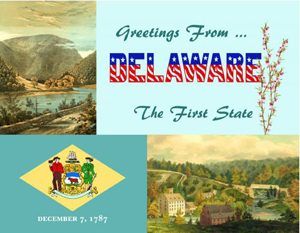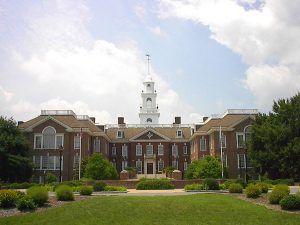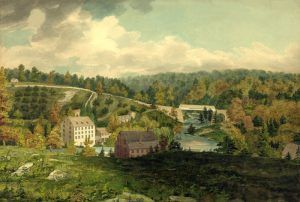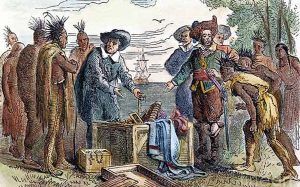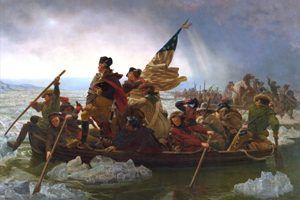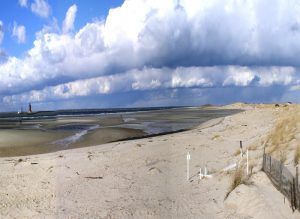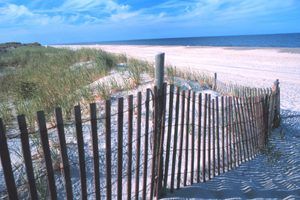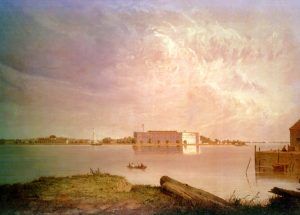With the state motto of “Liberty and Independence,” it’s no surprise that Delaware was the first of the original 13 states of the Union; it’s often called the “First” or “Diamond State.” The state’s name comes from the original governor of Virginia, Thomas West, Lord De La Warr. William Penn acquired the land that makes up Delaware to keep his Pennsylvania colony from being landlocked. Today, Delaware is one of the most industrialized states, known for its chemical research. Dover is the capital; the state flower is the peach blossom.
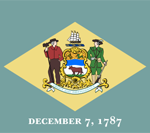 Adopted on July 24, 1913, the state flag has a background of colonial blue surrounding a diamond of buff color in which the coat of arms of the state of Delaware is placed. Below the diamond are the words “December 7, 1787,” indicating the day on which Delaware was the first state to ratify the federal Constitution. Because of this action, Delaware became the first state in the Union and is, therefore, accorded the first position in such national events as presidential inaugurations. According to members of the original commission established to design the flag, the shades of buff and colonial blue represent those of General George Washington’s uniform, as shown on a specific plate from an official U.S. Army publication.
Adopted on July 24, 1913, the state flag has a background of colonial blue surrounding a diamond of buff color in which the coat of arms of the state of Delaware is placed. Below the diamond are the words “December 7, 1787,” indicating the day on which Delaware was the first state to ratify the federal Constitution. Because of this action, Delaware became the first state in the Union and is, therefore, accorded the first position in such national events as presidential inaugurations. According to members of the original commission established to design the flag, the shades of buff and colonial blue represent those of General George Washington’s uniform, as shown on a specific plate from an official U.S. Army publication.
State Motto – “Liberty and Independence”
State Song – Our Delaware
State Bird: Blue Hen Chicken
State Flower: Peach blossom
State Tree: American Holly
Articles:
Initial Battles For Independence
Phantom Dragoon of the Delaware River
Settling of America – New England Settlements
The War of 1812 – American Independence Confirmed
Oh the hills of dear New Castle,
and the smiling vales between,
When the corn is all in tassel,
And the meadowlands are green;
Where the cattle crop the clover,
And its breath is in the air,
While the sun is shining over
Our beloved Delaware.
— From State Song, Our Delaware
Delaware – The First State
This Mid-Atlantic state bills itself as “not far from where you are” because it is easily reached by air, rail, or road. Its rolling Brandywine Valley is home to historic mansions, while southern beaches are favorite havens for city folks fleeing the summer heat. The state is smaller in area than any other but Rhode Island.
Before Europeans explored its coastline in the 16th century, Delaware was inhabited by several groups of Native Americans, including the Lenape in the north and Nanticoke in the south. The state was named after the Delaware River, which in turn derived its name from Thomas West, Lord De La Warr, the English governor of Virginia who first explored Delaware Bay in 1611. Though the Lenape called themselves “the people,” Europeans began to call them Delaware Indians, the name derived from the same source.
The first settlers in Delaware were Dutch colonists. They arrived in 1611 and established an outpost of the New Amsterdam Colony, which later became New York. The Dutch were joined a few years later by a colony of Swedes, accompanied by a number of Finns. They settled at the present site of Wilmington. The Dutch and the Swedes had many conflicts until 1655, when the Dutch captured the Swedish settlements. Nine years later, William Penn and other English colonists seized both the Dutch and Swedish settlements to keep the Pennsylvania colony from being landlocked.
The town of New Castle, a port on the Delaware River, became the colonial capital of the “Three Lower Counties” (Delaware) in 1704. The “Three Lower Counties” remained a part of Pennsylvania until 1776, when economic, cultural, and political differences fostered a permanent separation. The capital was moved from New Castle to Dover in 1777. In later years, many Scotch, Irish, and English Quakers settled in Delaware, and in Kent, there are today descendants of a shipload of Moors who were wrecked on the Delaware coast generations ago.
Delaware was one of the 13 colonies participating in the American Revolution. On December 7, 1787, Delaware became the first state to ratify the Constitution of the United States, thereby becoming known as “The First State.” Another one of its nicknames is the “Diamond State.”
The growth and prosperity of the state are inseparably interwoven with that of the great bay which provides Delaware with easy transportation, a mild climate, and quantities of good seafood. The state is a low plain, its average elevation being but 60 feet above the waters of the bay. Some of the richest farms are on land that has been recovered from the bay by the building of dikes.
Wilmington, the state’s largest city, was once a great manufacturing and shipbuilding center. Wilmington’s growth was largely due to the vision of a French family, the Dupon de Nemours, who settled here and began making explosives for the American army during the Revolutionary War. Wilmington-made explosives have helped win numerous wars in which our country has taken part. Today, the company is known as DuPont and is one of the largest chemical companies in the nation. Presently, Wilmington remains strong as a financial and service center for numerous corporations.
Delaware is one vast market garden. From one end of the state to the other, there is scarcely an acre of suitable land that is not cultivated, and the farmers have even pushed back the tidelands of the bay to reclaim thousands of acres formerly under water. The output of Delaware farms includes fruit, fresh vegetables, corn, wheat, hay, and dairy products.
Delaware Bay has been a source of wealth to the state’s people ever since colonial days. The Bay is one of the world’s greatest oyster beds. Its waters yield several kinds of fish, the most important being shad and sturgeon. Delaware Bay is connected with the Chesapeake Bay by a ship canal, 13 miles long, excavated across the state.
Though most Delaware towns are small, they are busy places, particularly during the summer season when the canneries operate. Delaware is widely known for canned goods, particularly tomatoes, peas, corn, and peaches.
Today, Delaware is one of the most industrialized states, known for its chemical research. Lying along the Atlantic coastline, most of Delaware lies in a low, flat coastal plain. The rolling hills and valleys of the Piedmont region cover the northern tip of the state. Delaware’s many freshwater lakes and ponds, ocean beaches, rivers, and streams provide excellent swimming, boating, and fishing. Cultural and historical attractions also attract visitors to the state.
Delaware Facts:
Capital: Dover
Population: More than 945,000 people live in Delaware.
Geography: This small, flat state is 48 kilometers wide, 154 kilometers long, and encompasses 6,452 square kilometers on the U.S. eastern seaboard.
Higher Education: The University of Delaware and Delaware State University both award bachelor’s, master’s, and doctoral degrees. Wesley College, affiliated with the United Methodist Church, was founded in 1873 and is the state’s oldest private college.
Major Industries are chemical manufacturing (home to E. I. du Pont de Nemours and Company, one of the world’s largest chemical companies), the manufacture of scientific instruments, and publishing.
Famous Delawareans include Vice President Biden, surgeon Henry Heimlich, and actress Valerie Bertinelli.
International connection: Delaware’s sister state in Japan is Miyagi Prefecture.
Nicknames: The First State because it was the first state to adopt the constitution. The “Diamond State” is a nickname given by Thomas Jefferson because he described Delaware as a “jewel” among states due to its strategic location on the Eastern Seaboard. The “Blue Hen State” was given to Delaware after the fighting Blue Hen Cocks that were carried with the Delaware Revolutionary War Soldiers for entertainment during Cockfights. “Small Wonder” is given to Delaware due to its size and the contributions it has made to our country as a whole, and the beauty of Delaware.
Fun facts:
- The state takes its name from Thomas West, the third Baron De La Warr, an English nobleman and Virginia’s first colonial governor.
- More than 50 percent of U.S. publicly traded corporations — 60 percent of Fortune 500 companies — are incorporated in Delaware.
- Because Delaware has no state sales tax, shopping is a popular pastime for residents and visitors alike.
© Kathy Alexander/Legends of America, updated February 2024.
Also See:
English Colonials to American Patriots
Sources:
America’s Story
Delaware Government
Taylor, Frank J. (Author) and Taylor, Ruth (Drawings), Our U.S.A.: A Gay Geography; Little, Brown, and Co, 1935
USA Embassy
Wikipedia

